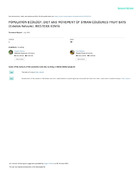| dc.description.abstract | The population status, movement, roost-site selection and diet of straw-coloured fruit bats (Eidolon helvum) were studied over a seven-month period in western Kenya. Overall, the bat population fluctuated markedly from as low as 7,000 to as high as >25,000 bats, and the bats shifted from one roosting camp to the other within the same general area, perhaps reflecting the seasonal variation in the availability of preferred foods. Preliminary results suggested that tree density was an important factor in roosting-camp selection for E. helvum in western Kenya, and the removal of roost trees could have serious ramifications on their conservation in the region. Germination experiments and direct observations indicated that E. helvum helped to disperse seeds of >32 plant species belonging to 18 families. Further monitoring is needed to provide a complete picture of the status and migration patterns of E. helvum in Kenya. Additionally, because the bats were viewed negatively with attendant persecution through roost-tree clearance and eradication programmes, a robust education and community outreach programme in local schools and local communities should be continued for the long-term conservation of viable populations of E. helvum in western Kenya. | en_US |
